The Skittles Room – ChessCafe.com (original) (raw)
Blue Belt Curriculum, Chapter One
November 4, 2023
Blue Belt Chess Curriculum, Chapter One
Can read and write algebraic notation
We will reiterate and expand on the lesson on chess notation from the White Belt Curriculum.
Knowing the letter designation for each chess piece and knowing the name of each square allows us to map the coordinates and follow the progression of any chess game from start to finish. To write down the moves in a chess game this way is called taking notation. Nearly all the countries in the world understand a system of notation called algebraic.
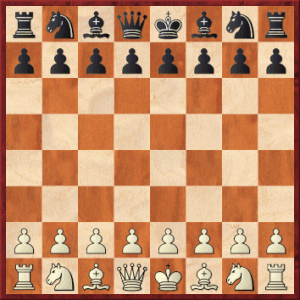
In algebraic notation each square of the chessboard is designated by the rank and file on which it stands. The columns that run from top to bottom of the chessboard are called files. There are eight files on the chessboard, and eight squares in each file. Each file has a name beginning with a letter. These are lettered a to h; i.e., from left to right, a-file, b-file, c-file, etc.
The rows that run from side to side are called ranks. There are also eight ranks on the chessboard, and eight squares in each rank. Each rank has a name beginning with a number. These are numbered one to eight; i.e., from bottom to top, first rank, second rank, third rank, etc.
By combining the file and rank designations, we can name each individual square. Thus, the first rank contains the squares a1, b1, c1, d1, e1, f1, g1, and h1. While the a-file contains the squares a1, a2, a3, a4, a5, a6, a7, and a8.
To write a chess move in algebraic you must note the following information for each side:
* The symbol of the unit on move (e.g. R, N, B, K, Q).
* The square that unit moves to (e.g. a1, b1, etc.).
For pawn moves we just note the square to which it moves; there is no symbol for the pawn. To record an en passant pawn capture, you simply write the destination square as normal. When the king castles to the kingside, it is written as 0-0. When the king castles queenside it is written as 0-0-0. A plus sign (+) is used to denote a check and the letter x signifies a capture. A checkmate is denoted by the number symbol (#). For other symbols regarding notation, see the appendix.
Using chess notation players can read and understand games that have been played centuries ago. In fact, the oldest recorded chess game is said to have been published in an Arabic manuscript by as-Suli and al-Lajlaj no later than AD 940. This was reproduced by H.J.R. Murray in the British Chess Magazine in November 1903 using a method known as descriptive notation.
Murray notes, “it is perhaps necessary to recapitulate the moves of the men in early Muhammadan chess. The Rook and Knight move as in modern chess. The Pawn has no initial double step, and can only be promoted to the rank of Queen. The Bishop leaps diagonally over one square, whether occupied or not, into the square beyond, and captures an opponent standing on that square.” He describes the game as a variation of the Sayyal or ‘Torrent’ Opening, which “derived its name from the hot attack – hot for old chess of course – which the early advance of the King’s Knight’s Pawn instituted.”
1.g3 g6 2.g4 f6 3.e3 e6 4.Ne2 d6 5.Rg1 c6

6.f3 b6 7.f4 a6 8.f5 gxf5 9.gxf5 exf5 10.Bh3 Ne7 11.Rf1 Rg8 12.Ng3 Rg5 13.Bxf5 h6 14.Bh3 Nd7 15.d3 d5 16.c3 Qc7 17.b3 Ra7 18.c4 Be6 19.Nc3 Bd6 20.cxd5 cxd5 21.d4 Bf8 22.Rf2 Qd6 23.b4 Rc7 24.Kd2 b5 25.Ba3 Nb6 26.Bc5 Nc6 27.a3 Kf7 28.Qc2 Bc4 29.Raf1 Rg6 30.Nh5 Ke8 31.Nxf6+ Kd8 32.Nfxd5 Rb7 33.Rxf8+ Kd7 34.Bf5+ Ke6 35.Nf4# Murray indicates that the e7-square is guarded by the white bishop on c5.
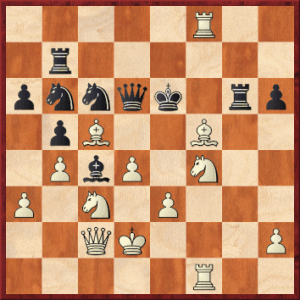
The following game was played in tenth century Baghdad by As-Suli, a grandmaster of his time. Murray writes, “To Eastern chess players the name of Assuli, the greatest player of the Abbasid period, is synonymous with all that is highest in the art of chess-play, and to say of a player that he played chess like Assuli was for centuries the highest praise that could be given to him.” In this game As-Suli playing black makes the first move. Until the mid-nineteenth century the convention did not exist that white makes the first move. As in the previous game, the bishop, then the fil, jumped over other pieces two squares along the diagonal, and the queen only moved one square diagonally.
1…f6 2.f3 f5 3.f4 Nf6 4.Nf3 c6 5.e3 c5 6.Bh3 g6 7.Nh4 e6 8.b3 Qe7 9.Qe2 Bh6 10.g3 Kf7 11.Nf3 Rd8 12.Ne5+ Kg8 13.Nd3 d6 14.Nf2 Nc6 15.d3 b6 16.e4 fxe4 17.dxe4 d5 18.Qd3 c4 19.bxc4 dxc4 20.Qxc4 Ba6
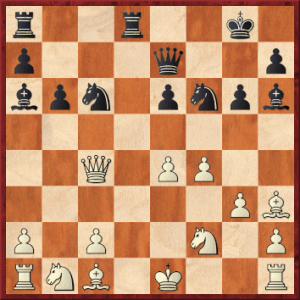
21.Qd3 On c4 the queen is attacked by the bishop, but not on d3. 21…Rac8 The queen was not as valuable a piece as it is today to warrant capture. 22.Nc3 Nb4 23.Na4 Rxc2 24.Bf1 Bc4 25.Nh3 Nxe4 26.a3 Re2+ 27.Kd1 Nxd3
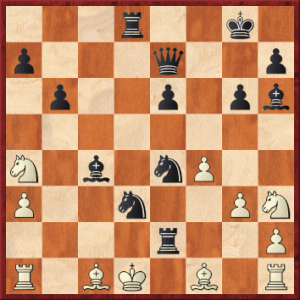
28.Bxd3 Rxd3#. The c4-bishop protects the d2-rook from capture.
Below are two modern games that prove the aphorism, often attributed to Viktor Korchnoi, that “everything in chess that has been forgotten is new.” Compare these positions to the first game above; played more than one thousand years apart!
Nepomniachtchi,Ian (2784) – Carlsen,Magnus (2863)
Legends of Chess Final chess24.com INT (2.11), 03.08.2020
Sicilian Najdorf [B90]
1.e4 c5 2.Nf3 d6 3.d4 cxd4 4.Nxd4 Nf6 5.Nc3 a6 6.Rg1 b5
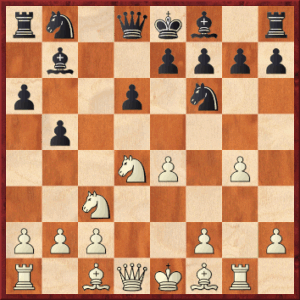
7.g4 Bb7 8.g5 Nfd7 9.a3 g6 10.h4 Bg7 11.h5 Nc6 12.Be3 Nc5 13.f3 0–0 14.hxg6 fxg6 15.Nxc6 Bxc6 16.Bh3 Bxc3+ 17.bxc3 e5 18.Bg4 Qe7 19.Qd2 Rad8 20.c4 bxc4 21.0–0–0 Ne6 22.Qc3 Bd7 23.Qxc4 Kg7 24.Qb4 Nf4 25.Bxf4 Bxg4 26.Rxg4 Rxf4 27.Rxf4 Qxg5 28.Rxd6 Qxf4+ 29.Kb1 Rxd6 30.Qxd6 h5 31.c4 Qxf3 32.Qxe5+ Qf6 33.Qd5 h4 34.c5 Qf1+ 35.Ka2 Qg2+ 36.Kb3 Qg3+ 37.Ka4 h3 38.c6 h2 39.Qd7+ Kh6 40.Qd8 Qe5 41.Qh4+ Kg7 42.Kb3 Qb5+ 43.Kc3 Qxc6+ 44.Kd3 Qd6+ 45.Ke2 Qxa3 46.Kf2 Qb2+ 47.Kg3 Qf6 48.Qh3 Qc3+ 0-1
Carlsen,Magnus (2835) – Abasov,Nijat (2632)
FIDE World Cup 2023 Baku AZE (7.1), 19.08.2023
Sicilian Rossolimo Attack [B30 ]
1.e4 c5 2.Nf3 Nc6 3.Bb5 e6 4.Bxc6 bxc6 5.b3 d6 6.e5 dxe5 7.d3 f6 8.Nbd2 Nh6 9.Rg1 Ba6 10.g4
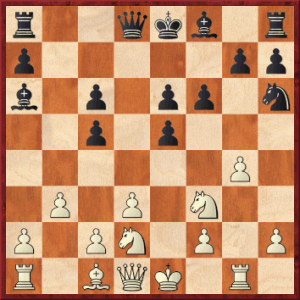
10…Nf7 11.Qe2 Be7 12.Bb2 Qa5 13.c4 g5 14.h4 h6 15.Rh1 0–0–0 16.0–0–0 Qc7 17.Ne4 gxh4 18.Nxh4 Rhg8 19.f4 exf4 20.Nxf6 Bxf6 21.Qxe6+ Kb8 22.Qxf6 Bc8 23.Rde1 Rd6 24.Qxf4 Rxg4 25.Qe3 Re6 26.Qd2 Ne5 27.Kc2 Kb7 28.Re3 Qe7 29.Nf5 Qg5 30.Bxe5 Rg2 31.Re2 Rxe2 32.Qxe2 Qxf5 33.Rh5 Qf7 34.Qh2 Rg6 35.Bf4 Rf6 36.Be3 Bf5 37.Bxc5 Qg6 38.Kc3 Re6 39.Rh4 Bg4 40.Bxa7 Qf6+ 41.Kb4 Re5 42.d4 Qe7+ 43.c5 1-0
According to the International Chess Federation (FIDE) handbook Laws of Chess “It is forbidden to record the moves in advance.” Thus, one must play the move on the board and then write it on the scoresheet. To do otherwise would constitute taking notes, which is forbidden. However, such was not always the case.
In The Life and Games of Mikhail Tal (Cadogan Books, 1997), Tal reported the following incident from a game in the Candidates’ tournament at Bled, 1959:
Fischer,Robert James – Tal,Mihail
Candidates Tournament Bled/Zagreb/Belgrade (27), 26.10.1959
Sicilian Scheveningen [B87]
1.e4 c5 2.Nf3 d6 3.d4 cxd4 4.Nxd4 Nf6 5.Nc3 a6 6.Bc4 e6 7.Bb3 b5 8.f4 b4 9.Na4 Nxe4 10.0–0 g6 11.f5 gxf5 12.Nxf5 Rg8 13.Bd5 Ra7 14.Bxe4 exf5 15.Bxf5 Re7 16.Bxc8 Qxc8 17.Bf4 Qc6 18.Qf3 Qxa4 19.Bxd6 Qc6 20.Bxb8 Qb6+ 21.Kh1 Qxb8
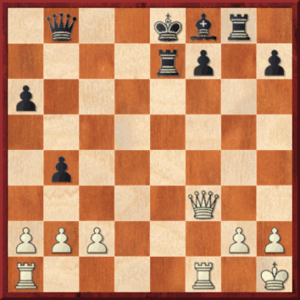
“Every player has his own habit: one will first make his move and then write it down, while another will do things the other way round. Incidentally, in recent years Fischer has actively objected to this ‘other way round’, expressing the opinion that a scoresheet is not a black-board for writing down exercises. However, in our game Fischer first wrote down the move 22 Rae1!, without doubt the strongest, and wrote it not in his usual English notation but in European, almost Russian! Then he not very deftly pushed the scoresheet towards me. ‘He’s asking for an endorsement’, I thought to myself, but how was I to react? To frown was impossible, if I smiled he would suspect ‘trickery’, and so I did the natural thing. I got up and began to calmly walk up and down the stage. I met Petrosian, made some joke to him, and he replied. The 15-year-old Fischer, who was essentially still only a large child, sat with a confused expression on his face, looking first at the front row of the spectators where his second was sitting, and then at me.
“Then he wrote down another move: 22.Qc6+?, and after 22…Rd7 23.Rae1+ Be7 24.Rxf7 Kxf7 25.Qe6+ Kf8! 26.Qxd7 Qd6 held on to my extra piece and adjourned the game in a won position. When I later asked Fischer why he hadn’t played 22 Rael, he replied: ‘Well, you laughed when I wrote it down!’”
The chess engine evaluates 22.Rae1 as equal, and 22.Qc6+ as giving Black a clear advantage.
The game concluded as follows: 27.Qb7 Rg6 28.c3 a5 29.Qc8+ Kg7 30.Qc4 Bd8 31.cxb4 axb4 32.g3 Qc6+ 33.Re4 Qxc4 34.Rxc4 Rb6 35.Kg2 Kf6 36.Kf3 Ke5 37.Ke3 Bg5+ 38.Ke2 Kd5 39.Kd3 Bf6 40.Rc2 Be5 41.Re2 Rf6 42.Rc2 Rf3+ 43.Ke2 Rf7 44.Kd3 Bd4 45.a3 b3 46.Rc8 Bxb2 47.Rd8+ Kc6 48.Rb8 Rf3+ 49.Kc4 Rc3+ 50.Kb4 Kc7 51.Rb5 Ba1 52.a4 b2 0-1
For classroom exercises related to chess notation, please refer to the White Belt Chess Curriculum. From this point onwards the student should regularly be recording their games using algebraic notation.
Not a Member Yet?
To read this content you will need to become a member. To do this, please fill out the form in the sidebar or click here to Become a Member.